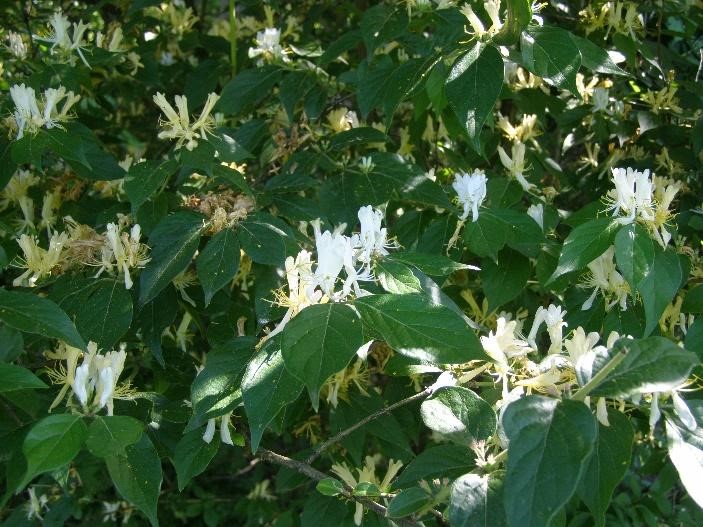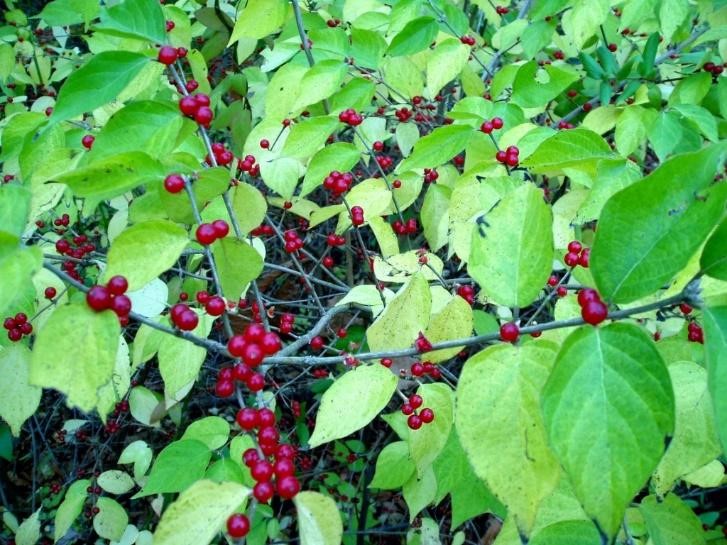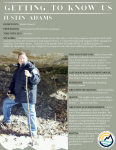By Madeline Pruszenski

The yellow and white flowers of the bush honeysuckle fill the spring air with sweet fragrance. Its green leaves hold on throughout the fall, a reminder of warm days before winter sets in. So it may come as a surprise that this seemingly pleasant plant is actually an aggressive invasive species.
Scientists have long known that bush honeysuckle (Lonicera maackii), brought to North America from Asia as an ornamental plant, competes with native plant species and reduces their chances of survival. However, they only recently have begun to understand the negative effect it has on aquatic ecosystems.
Richard Durtsche, the Research and Education Field Station director at Northern Kentucky University, and his team investigated the effects of invasive honeysuckle on aquatic communities. They found that something as simple as its leaf litter — leaves that fall into water bodies in autumn — can be harmful to water quality and aquatic life.

Bush honeysuckle flowers in the spring. Photo courtesy of Boone County Conservation District. 
Bush honeysuckle berries in the fall
Photo courtesy of Boone County Conservation District.
Photo courtesy of Boone County Conservation District.
This finding is important considering how abundant bush honeysuckle is in the Kentucky region and where it is often found.
“It proliferates along roadsides, and dominates aquatic edges of streams, rivers, lakes, and ponds,” Durtsche said. “You will find these areas loaded with honeysuckle.”
What the Leaves Say
To study leaf litter in a lab setting, the team created test “ponds” using one-liter containers of water and dry leaf litter from both bush honeysuckle and native plants. They calculated the amount of leaves that would be in one liter of water, put them in tea bags and placed them in the containers.
Among its findings, the NKU team observed high microbial activity on the bush honeysuckle leaves. The direct effects of the microbes on aquatic organisms are not yet know. However, they noted the microbes appear to decrease the dissolved oxygen levels in the water while breaking down the leaves in the water.

“The leaves decompose so much faster because the bacteria break down the leaves quickly while using up the oxygen in the water,” Durtsche said. This leaves less oxygen for organisms to thrive.
The team found that bush honeysuckle leaves decompose 3-5 times faster than the native sycamore leaves, also commonly found along aquatic edges.
This is of particular concern for aquatic communities surrounded by a large number of bush honeysuckle, since leaf litter is an important part of the food chain. If bush honeysuckle makes up of the majority of the leaf litter, this food source will become depleted faster than if native leaves were in the water.
A Danger to Frogs
Durtsche’s team also found that bush honeysuckle appears to affect amphibians, such as wood frogs. As bush honeysuckle leaves decompose in water they release tannin chemicals, a “defense mechanism by the plant to reduce digestibility in herbivores,” Durtsche said.
To see how the release of these chemicals impacted the fitness of young frogs, the team raised tadpoles in two aquatic environments: one with bush honeysuckle leaves and one without. After the tadpoles grew into froglets, the team measured the froglets’ ability to escape predators and overall health.
The froglets that spent time in the bush honeysuckle leaf litter test appeared to have reduced fitness and reduced overall health compared to the wood frogs in the control test, the team said.
Additionally, honeysuckle transpiration — in which water moves up plant roots and evaporates from the plants’ leaves — occurs at a higher rate than native shrubs. This can decrease the amount of water available in these ponds, as well as the duration of time that water is available.
“Honeysuckle increases transpiration from a forest by 10 percent,” said NKU Research and Education Field Station Assistant Director Richard Boyce, who worked with Durtsche to analyze the effects this has on aquatic habitats. “In return, it reduces water that flows out of wetlands and can actually affect stream flow”.
This concern is specific to amphibians because amphibians lay their eggs in ponds, some of which only hold water certain times of the year. If the “pond’s life is too short,” Durtsche said, “then amphibians won’t lay eggs there.”
Looking Toward the Future
Boyce, citing his new research, offered some optimism: honeysuckle leaf blight attacks, and eventually kills, honeysuckle leaves, and it appears to have little impact on native species.
The leaf blight might not eliminate bush honeysuckle, Boyce said, but there is“potential that it will knock back its competitive advantages, making it a more normally growing plant.”
Landowners wanting to prevent the negative effects of bush honeysuckle can look around their properties to see if bush honeysuckle has taken residence on the land. Properly identify the plant as honeysuckle by looking at the characteristics described here.
Boyce said the best way to kill small bush honeysuckle is by pulling it up, but make sure to get all of the roots. If it’s a bigger plant, Boyce says the most effective way is to cut it at the stump and spray the stump with a glyphosate-based herbicide. Contact your local UK Extension office for the correct application and mixture rates.
Getting rid of bush honeysuckle can be labor intensive, but working to stop the spread of this aggressive plant will in the end help improve the land and aquatic ecosystems.
Madeline Pruszenski is an environmental scientist with the Kentucky Division of Water. She has a passion for ecology, especially regarding freshwater systems, and works to educate the public about water quality.







What an awakening! I remember as a kid, my friend and I would cut clusters of honeysuckles and pick each flower for it’s delicious treat. Now, as an adult, when i smell that sweet fragrance, it takes me back to those carefree childhood days. Who would have ever known how something so sweet and beautiful could be so detrimental.
LikeLike
Good article about an invasive plant. Can you include the species name? Several Lonicera species are commonly known as bush honeysuckle.
LikeLike
Lonicera maackii. Thank you for pointing this out! We’ve updated the story to include the scientific name.
LikeLike
I am sensitive to glyphosate. I have hundreds of small stumps from honeysuckle that I cut down. (Have more to do!)
What other options will kill the roots and stumps?
I’ve tried digging them out, and am often failing to get the whole root out – which just means they’ll grow back in spring.
My yard has a drain that runs to the river. I’d like to get rid of as much honeysuckle as I can.
LikeLike
This site has some information about ways to control bush honeysuckle: https://www.knps.org/2020/04/30/invasive-plant-corner-bush-honeysuckle-lonicera-spp/. Your local Extension Office may also be able to provide guidance for what would be effective on your property. Good luck, and thank you for reading!
LikeLike
Can you please include the scientific name?
LikeLike
Lonicera maackii. Thank you for pointing this out. We’ve updated the story to include the scientific name.
LikeLike
If the department directs local removal of honeysuckle, there is a large swath of it along the East-West Connector in Frankfort. It probably is not necessary to search for it. It is everywhere. Kentucky’s Kudzu.
LikeLike
12-14-20: For about 8 years I’ve been a certified Montgomery County Weed Warrior in Maryland and in the last two years work a lot on removing Bush Honeysuckle and found it to be one of my favorite workouts. The larger they are (up to about 3 inches diameter) I cut off up to 3 or 4 feet. These plants have NO tap root, and if the soil is wet after a rain, can be torqued out of the ground pushing and pulling on the remaining trunk. You will know quickly if it’s going to work. If it’s solid, use a pick to drive under the roots about 6 to 12 inches away from the stump center. The roots break or pull out relatively easy. If not, go a few inches more away. After a few roots on one side of the stump no longer connect it to the earth…torque it again…away from the roots you have damaged. Wow! It’s rewarding. We have uncovered over 200 Pawpaw trees that were completely covered by more than a thousand BHs. We were fortunate to have over 700 native plants and many bags of seeds to put in many the disturbed soil spots from stump removal. And lucky to have city workers haul away most of the cuttings. Now, in other city parks we are just ‘lopping and dropping’ the cuttings. I used a block and tackle to take out a few larger ones I couldn’t do by hand. And there are some monsters we will just keep cutting new growth off until the roots starve. It’s much cheaper than a gym membership…and the free fresh air, non-covid-19 exposure is priceless. Weed wrenches work well if you’re tired. Next I’m going to experiment with a 4 foot long heavy pipe (about the same as a weed wrench) with a 3 inch inside diameter opening on both ends. BH with 2 inch stumps cut about a foot off the ground will be my test target. Other size pipes will follow.
LikeLike
I’ve been a certified Montgomery County Weed Warrior in Maryland for about 8 years. In the last two years my fellow weed warriors and I have work a lot on removing Bush Honeysuckle. I’ve found it to be one of my favorite workouts. The larger they are (up to about 3 inches diameter) I cut off about 3 or 4 feet from the ground…and remove any smaller limbs in the way. These plants have NO tap root! And if the soil is wet after a rain, they can be torqued out of the ground by pushing and pulling on the remaining trunk. You’ll know quickly if it’s not going to work. If it’s solid, use a pick to drive under the roots about 6 to 12 inches away from the stump center. The roots break or pull out relatively easy. If not, go a few inches more away. Work in a circle round the stump doing the same thing. After a few roots on one side of the stump are no longer connect to the earth…torque it again away from the roots you have cut. Repeat until you beat it. It’s rewarding. We have uncovered over 200 Pawpaw trees that were completely covered by more than a thousand BHs. We were fortunate to have over 700 native plants and multiple bags of native seeds to put in many the disturbed soil spots after stump removal. And luckier to have city workers haul away most of the cuttings. Now, in other city parks and county parks we are just ‘lopping and dropping’ the cuttings. I did use a block and tackle to take out a few larger stumps that I couldn’t do by hand. Time consuming but doable if you have a strong tree nearby and your protect its bark while using it for an anchor.
There are monster stumps we will just keep cutting new growth off of…until the roots starve.
This workout is much cheaper than a gym membership…and the free fresh air, non-covid-19 exposure atmosphere is priceless. Weed wrenches work well if you’re tired.
Next I’m experimenting with a 4 foot long heavy pipe (about the same weight as a weed wrench) with a 3 inch inside diameter opening. And use it on BH that have about a 2 inch diameter stump that is cut about a foot off the ground. I’m excited to see if this size BH can be torqued out of the ground with just a pipe. Other sized pipes will follow.
LikeLiked by 1 person
Wonderful article with some great info, thank you for posting it. Are there weed warriors in other states?
LikeLike